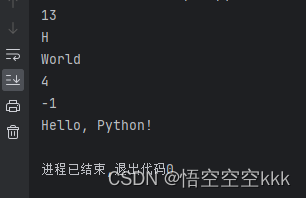全网最细,python中关于字符串常用方法的总结与说明 举例说明 附源码可直接运行
发布时间:2024年01月20日
Python中关于字符串的方法非常多,下面列举一些常用的方法:
字符串基本操作:
len(str):返回字符串str的长度。str[index]:返回字符串str中索引为index的字符。str[start:end]:返回字符串str中从索引start到end-1的子串。str.find(sub):返回字符串str中第一次出现子串sub的位置。如果没有找到,返回-1。str.replace(old, new):将字符串str中的所有old子串替换成new子串。
# 字符串基本操作:
# len(str): 返回字符串str的长度。
str1 = "Hello, World!"
print(len(str1)) # 输出 13
# str[index]: 返回字符串str中索引为index的字符。
str2 = "Hello, World!"
print(str2[0]) # 输出 'H'
# str[start:end]: 返回字符串str中从索引start到end-1的子串。
str3 = "Hello, World!"
print(str3[7:12]) # 输出 'World'
# str.find(sub): 返回字符串str中第一次出现子串sub的位置。如果没有找到,返回-1。
str4 = "Hello, World!"
print(str4.find("o")) # 输出 4
print(str4.find("Python")) # 输出 -1
# str.replace(old, new): 将字符串str中的所有old子串替换成new子串。
str5 = "Hello, World!"
new_str = str5.replace("World", "Python")
print(new_str) # 输出 'Hello, Python!'?运行结果如下:

字符串转换:
str.upper():返回字符串str的大写形式。str.lower():返回字符串str的小写形式。str.capitalize():返回字符串str的首字母大写形式。str.title():返回字符串str的单词首字母大写形式。str.strip():返回字符串str去除两侧空格的形式。
?
# 字符串转换:
# str.upper(): 返回字符串str的大写形式。
str1 = "Hello, World!"
print(str1.upper()) # 输出 'HELLO, WORLD!'
# str.lower(): 返回字符串str的小写形式。
str1 = "Hello, World!"
print(str1.lower()) # 输出 'hello, world!'
# str.capitalize(): 返回字符串str的首字母大写形式。
str1 = "hello, world!"
print(str1.capitalize()) # 输出 'Hello, world!'
# str.title(): 返回字符串str的单词首字母大写形式。
str1 = "hello, world!"
print(str1.title()) # 输出 'Hello, World!'
# str.strip(): 返回字符串str去除两侧空格的形式。
str1 = " Hello, World! "
print(str1.strip()) # 输出 'Hello, World!'?结果如下:

字符串分割与连接:
str.split(sep):使用sep作为分隔符,将字符串str分割成一个列表。str.join(iterable):将可迭代对象iterable中的元素用字符串str连接成一个新的字符串。
# 字符串分割与连接:
# str.split(sep): 使用sep作为分隔符,将字符串str分割成一个列表。
str1 = "apple,banana,orange"
lst = str1.split(",")
print(lst) # 输出 ['apple', 'banana', 'orange']
# str.join(iterable): 将可迭代对象iterable中的元素用字符串str连接成一个新的字符串。
lst = ['apple', 'banana', 'orange']
str2 = ",".join(lst)
print(str2) # 输出 'apple,banana,orange'?结果如下:

字符串判断:
str.startswith(prefix):判断字符串str是否以“prefix”开头。str.endswith(suffix):判断字符串str是否以”suffix“结尾。str.isalpha():判断字符串str是否全由字母组成。str.isdigit():判断字符串str是否全由数字组成。
# 字符串判断:
# str.startswith(prefix): 判断字符串str是否以prefix开头。
str = "Hello, World!"
print(str.startswith("Hello")) # 输出 True
print(str.startswith("Python")) # 输出 False
# str.endswith(suffix): 判断字符串str是否以suffix结尾。
str = "Hello, World!"
print(str.endswith("World!")) # 输出 True
print(str.endswith("Python!")) # 输出 False
# str.isalpha(): 判断字符串str是否全由字母组成。
str = "Hello"
print(str.isalpha()) # 输出 True
str = "Hello123"
print(str.isalpha()) # 输出 False
# str.isdigit(): 判断字符串str是否全由数字组成。
str = "123"
print(str.isdigit()) # 输出 True
str = "Hello123"
print(str.isdigit()) # 输出 False
?结果如下:

?如果这篇文章对你有帮助,还请帮忙点赞关注。您的支持是我更新的最大动力!
? ? ? ? ? ? ? ? ? ? ? ? ? ? ? ? ? ? ? ? ?
文章来源:https://blog.csdn.net/k321805624/article/details/135702044
本文来自互联网用户投稿,该文观点仅代表作者本人,不代表本站立场。本站仅提供信息存储空间服务,不拥有所有权,不承担相关法律责任。 如若内容造成侵权/违法违规/事实不符,请联系我的编程经验分享网邮箱:chenni525@qq.com进行投诉反馈,一经查实,立即删除!
本文来自互联网用户投稿,该文观点仅代表作者本人,不代表本站立场。本站仅提供信息存储空间服务,不拥有所有权,不承担相关法律责任。 如若内容造成侵权/违法违规/事实不符,请联系我的编程经验分享网邮箱:chenni525@qq.com进行投诉反馈,一经查实,立即删除!
最新文章
- Python教程
- 深入理解 MySQL 中的 HAVING 关键字和聚合函数
- Qt之QChar编码(1)
- MyBatis入门基础篇
- 用Python脚本实现FFmpeg批量转换
- 金光集团APP中国企业社会责任领域屡获嘉奖
- 2023-12-22 LeetCode每日一题(得到山形数组的最少删除次数)
- API是什么?API的基础知识你知道多少
- 归并排序算法(Java实现)
- CEC2017(Python):六种算法(PSO、DBO、HHO、SSA、DE、GWO)求解CEC2017(提供完整Python代码)
- 破局:国内市场确实存在“消费升级”和“消费降级”,3.0全新新零售商业模式
- 【C 】static 关键字
- 学习python仅此一篇就够了(python容器:列表)
- 图片分类: 多类别
- 计算机组成原理——指令系统41-60